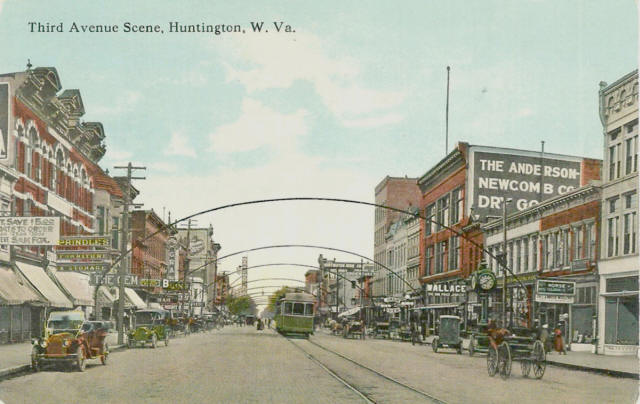
------------------------------------------------------------------------------------------------------

This vintage postcard of 3rd. Avenue offers a good view of the
Anderson-Newcomb.
It's not postmarked so it can't be precisely dated. But it was printed somewhere
between 1902 when the original three-story building was built and 1920 when
three more floors were added.
------------------------------------------------------------------------------------------------------
Editor's note: This is the 165th in a series of articles recalling vanished Huntington scenes.
HUNTINGTON -- For decades, the Anderson-Newcomb Co. was
a mecca for local shoppers.
The store began in 1894 when J.W. Valentine opened a small dry goods shop
on 9th Street
between 3rd and 4th avenues. The following year saw W.H. Newcomb
join the business, which was christened Valentine & Newcomb.
In 1902, the two partners erected a three-story brick building
on the south side of 3rd
Avenue between 9th and 10th streets. In 1907, Valentine sold his interest in the
store to E.G. Anderson, and the firm was renamed the Anderson-Newcomb Co.
A three-story annex was constructed in 1913, the first of many
additions and alternations in the
store's structure over the years. In 1920, three floors were added to the main
building.
In 1927, the familiar marquee was placed across the store's front.
In 1954, a two-story addition was constructed.
0ver the years, Anderson-Newcomb recorded a long list of local
"firsts" - the first store
in Huntington to have a horse-drawn delivery wagon, the first to trade its
horse and
wagon for a truck, the first to have a passenger elevator, the first
to reward its
employees with paid vacations and the first to install a telephone switchboard.
An unusual fixture at the store was a pneumatic tube system that connected
its sales clerks to a central cashier's office.
In 1970, the store was purchased by the Wheeling-based Stone &
Thomas chain
but continued to operate it under the Anderson-Newcomb name until 1980.
In 1996, Stone & Thomas closed the longtime store. The
building then sat vacant and
neglected until 2013 when it was purchased by Marshall University. Saving it
from likely demolition, the university dramatically transformed
it into a home for its visual arts program.
-----------------------------------------------------------
Note: This Article and picture appeared in the Herald-Dispatch Newspaper on Jan. 09, 2017.
-----------------------------------------------------------
[ Back ]